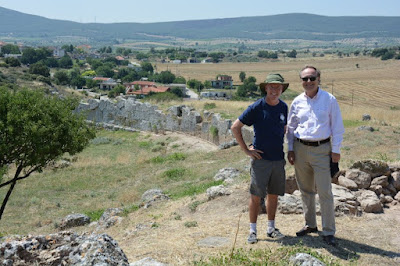This unique construction is made of huge stones, each perfectly cut for its place in a semi-circle of nearly 100 meters. This wall was another focal point of our research in 2015. We found that the foundations for the wall were perhaps more impressive than the wall itself, going nearly 4 m in height.
The wall’s skillful construction is remarkable because Eleon is not a significant Greek polis (city-state) and it does not have a prominent role in any of the historical texts from ancient Greece. Although Homer does include Eleon in his Catalogue of Ships (Iliad, 2:500), with Eleon leading the contingent of Greeks who set off to fight the Trojan war, in later sources we hear about Eleon only in connection with certain individuals. In particular, a seer or prophet named Bakis is said to come from Eleon.This short summary of our results leaves out much of what makes our project special – that is, the people with whom we work. Our Canadian and American students were truly exceptional this year – dedicated, cheerful and resilient. Our staff of experts were focused, professional and dedicated to making our project as good as it can be. The Canadian Institute in Greece, as always, provides great support for our research. We are also very grateful to the Canadian Embassy for inviting us to a pool party at the ambassador’s residence, and to Ambassador Peck himself, for his hospitality and for his personal visit to the site earlier this month. Finally, we also must note that, as a synergasia, we rely on our Greek partners based at the Thebes Museum for intellectual and administrative advice and collaboration. As government employees of the Greek state, our colleagues are faced with many challenges and uncertainties, and this summer they likely faced the most difficult time of their professional lives. Through it all, however, our partners were able to look beyond political and economic turmoil and were focused on one of Greece’s most valuable resources, its incredibly rich cultural history. We are sincerely grateful for the generosity they have shown in maintaining our partnership.Brendan Burke & Bryan BurnsUniversity of Victoria & Wellesley College








No comments:
Post a Comment